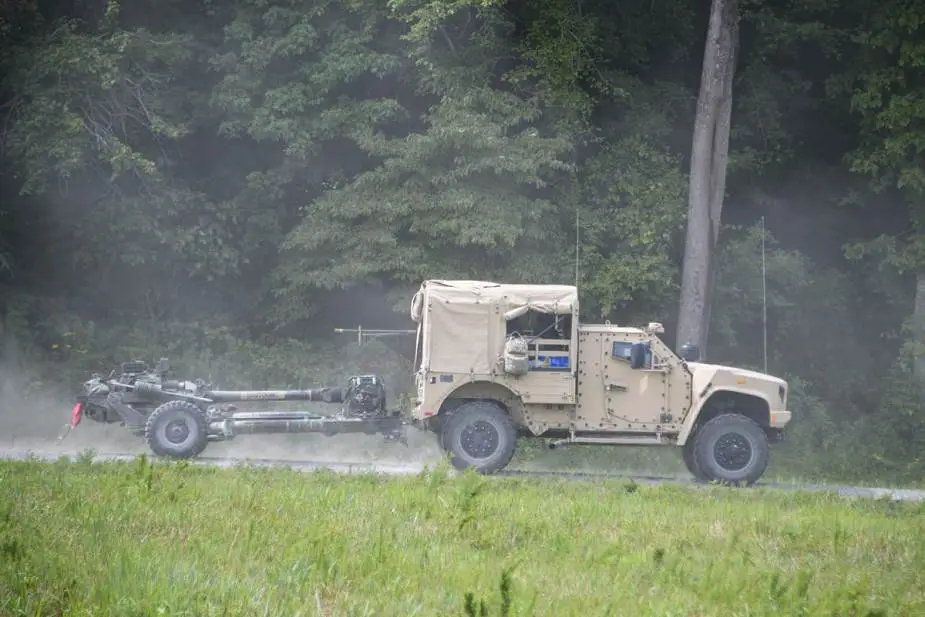According to information published by the U.S. Army on September 30, 2021, 101st Airborne Division field artillery Soldiers have been testing modified Joint Light Tactical Vehicles (JLTV) to serve as the prime mover and ammunition carrier for their M119A3 105mm Howitzers.
Follow Army Recognition on Google News at this link

A U.S Army Joint Light Tactical Vehicle (JLTV) towing an M119A3 105mm Howitzer conducts a survivability move between firing points during the JLTV Fires Integration Test at Fort Campbell, Kentucky. (Picture source U.S. Army)
Soldiers of 2nd Battalion, 32nd Field Artillery (FA) Regiment, 1st Infantry Brigade Combat Team (IBCT), 101st Airborne Division (Air Assault) conducted a Fires Integration Operational Test of the JLTV to validate the vehicle’s operational suitability and to inform decisions for fielding to combat units across the Army.
Boldsteel Soldiers took the lead putting the modified JLTVs into action during a live-fire pilot test, which was followed by a live-fire record test in inclement weather conditions and during both day and night.
The operational test at Fort Campbell, according to Maj. Austin BuChans, a test officer with the Fort Sill, Oklahoma-based Fire Support Test Directorate, was needed to see if the new JLTV configurations can serve as a suitable replacement for the HMMWV by field artillery units.
Field Artillery units within an Infantry Brigade Combat Teams (IBCT) have historically used the High Mobility Multipurpose Wheeled Vehicle (HMMWV; colloquial: Humvee) to tow their 105mm howitzers into combat, along with their Fire Direction Centers (FDC), ammunition, and other necessary equipment.
The Joint Light Tactical Vehicle (JLTV) was a program launched in 2011 by the United States Army and Marine Corps to replace the High Mobility Multipurpose Wheeled Vehicle (HMMWV nicknamed HUMVEE), 4x4 light tactical vehicle in service with the U.S. armed forces since 1985.
In August 2015, United States has announced that the company Oshkosh was selected for the production of JLTVs. The JLTV contract award has a value of up to US$6.749 billion and calls for a maximum of 16,901 JLTVs and includes a sustainment element.
The JLTV family now consists of three base vehicle platforms, Utility (JLTV-UTL), Close Combat Weapons Carrier (JLTV-CCWC) and General Purpose (JLTV-GP). The Utility base vehicle platform is a two-door configuration, the General Purpose and Close Combat Weapons Carrier base vehicle platforms are a four-door configuration. Standard U.S. military M-designators are applied base vehicle platforms when outfitted to a specific Mission Package Configuration. Current variants in service with the U.S. Armed Forces, M1278 Heavy Guns Carrier (JLTV-GP), M1279 Utility (JLTV-UTL), M1280 General Purpose (JLTV-GP) and M1281 Close Combat Weapons Carrier) (LTV-CCWC).
The M119A3 is a 105mm light towed howitzer which has a weight of 2,130 kg and which can be towed by HMMWV, 2.5 ton and 5-ton trucks. The A3 version of the M119 is fitted with a digital fire control system and an inertial navigation system for self-location entered service in April 2013 with A Battery 3/319th Field Artillery at Fort Bragg, NC. The gun can fire standard ammunition at a maximum range of 17,500 and can reach a firing of 19,500 with extended range ammunition.














